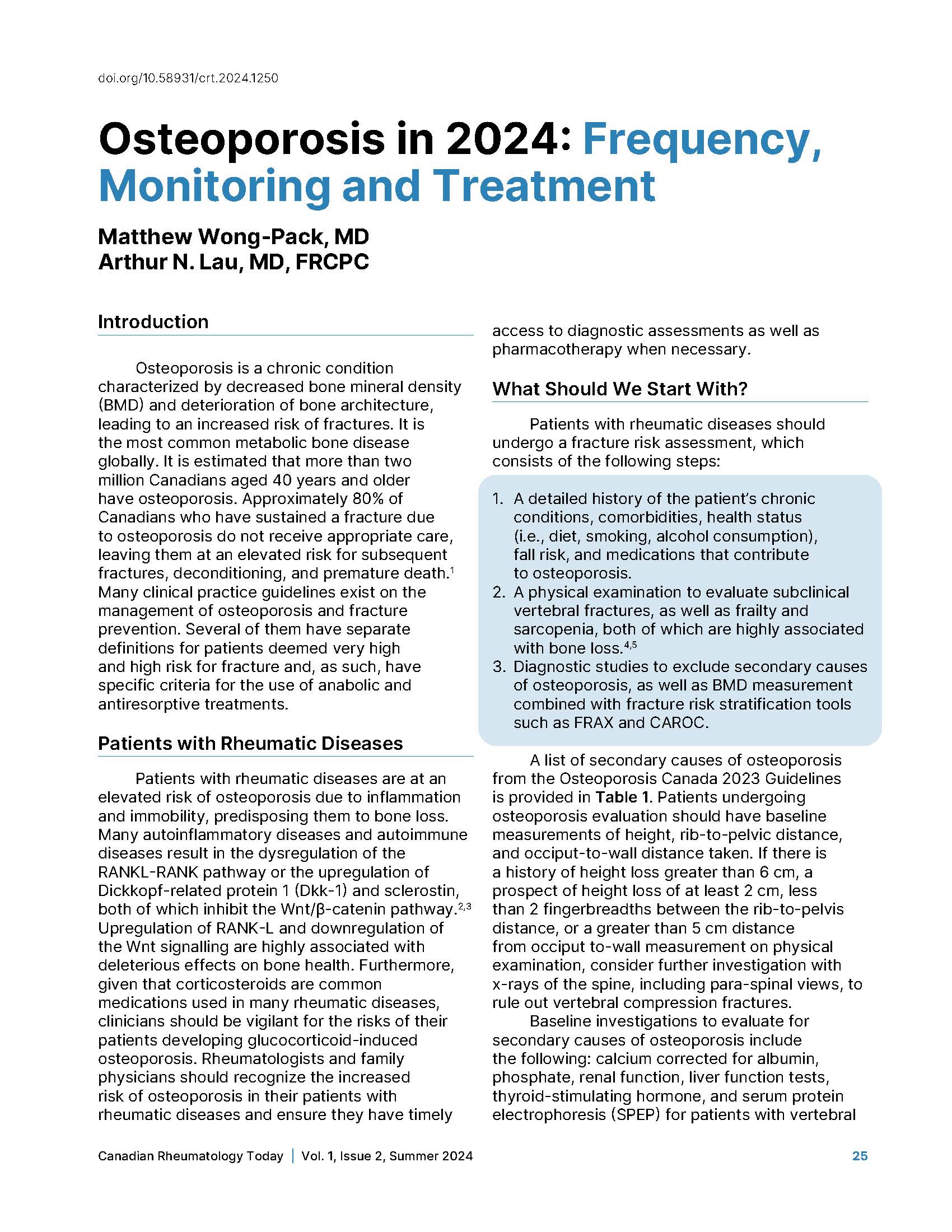Osteoporosis in 2024: Frequency, Monitoring and Treatment
DOI:
https://doi.org/10.58931/crt.2024.1250Abstract
Osteoporosis is a chronic condition characterized by decreased bone mineral density (BMD) and deterioration of bone architecture, leading to an increased risk of fractures. It is the most common metabolic bone disease globally. It is estimated that more than two million Canadians aged 40 years and older have osteoporosis. Approximately 80% of Canadians who have sustained a fracture due to osteoporosis do not receive appropriate care, leaving them at an elevated risk for subsequent fractures, deconditioning, and premature death.1 Many clinical practice guidelines exist on the management of osteoporosis and fracture prevention. Several of them have separate definitions for patients deemed very high and high risk for fracture and, as such, have specific criteria for the use of anabolic and antiresorptive treatments.
References
Public Health Agency of Canada. Osteoporosis and related fractures in Canada: report from the Canadian Chronic Disease Surveillance System. Ottawa ; 2020.
Boyce BF, Xing L. Functions of RANKL/RANK/OPG in bone modelling and remodeling. Arch Biochem Biophys. 2008;473(2):139-46. DOI: https://doi.org/10.1016/j.abb.2008.03.018
Rossini M, Gatti D, Adami S. Involvement of WNT/β-catenin signaling in the treatment of osteoporosis. Calcif Tissue Int. 2013;93(2):121-32. DOI: https://doi.org/10.1007/s00223-013-9749-z
Yu X, Sun S, Zhang S, et al. A pooled analysis of the association between sarcopenia and osteoporosis. Medicine. 2022;101(46: e31692. DOI: https://doi.org/10.1097/MD.0000000000031692
Li G, Thabane L, Papaioannou A, et al. An overview of osteoporosis and frailty in the elderly. BMC Musculoskelet Disord. 2017;18(1):46. DOI: https://doi.org/10.1186/s12891-017-1403-x
Kanis JA, Harvey NC, McCloskey E, et al. Algorithm for the management of patients at low, high and very high risk of osteoporotic fractures. Osteoporos Int. 2020;31(1):1-12. DOI: https://doi.org/10.1007/s00198-019-05176-3
Camacho PM, Petak SM, Binkley N, et al. American Association of Clinical Endocrinologists/American College of Endocrinology Clinical Practice Guidelines for the Diagnosis and Treatment of Postmenopausal Osteoporosis 2020 Update. Endocr Pract. 2020 May 1;26(5):564-70.
Shoback D, Rosen CJ, Black DM, et al. Pharmacological management of osteoporosis in postmenopausal women: an endocrine society guideline update. J Clin Endocrinol Metab. 2020 Mar 1;105(3):587-94. DOI: https://doi.org/10.1210/clinem/dgaa048
Khan AA, Alrob HA, Ali DS, et al. Guideline No. 422g: Menopause and Osteoporosis. JOGC. 2022 May 1;44(5):527-536.e5. DOI: https://doi.org/10.1016/j.jogc.2021.09.013
North American Menopause Society. Management of osteoporosis in postmenopausal women: the 2021 position statement of The North American Menopause Society. Menopause. 2021;28(9):973-7. DOI: https://doi.org/10.1097/GME.0000000000001831
Curtis J, Arora T, Liu T, et al. Comparative effectiveness of denosumab versus alendronate among postmenopausal women with osteoporosis in the U.S. Medicare program. In: ACR Convergence 2023. San Diego: American College of Rheumatology; 2023.
Kendler DL, Marin F, Zerbini CAF, et al. Effects of teriparatide and risedronate on new fractures in post-menopausal women with severe osteoporosis (VERO): a multicentre, double-blind, double-dummy, randomised controlled trial. The Lancet. 2018 Jan 20;391(10117):230-40. DOI: https://doi.org/10.1016/S0140-6736(17)32137-2
Saag KG, Petersen J, Brandi ML, et al. Romosozumab or alendronate for fracture prevention in women with osteoporosis. N Engl J Med. 2017 Sep 11;377(15):1417-27. DOI: https://doi.org/10.1056/NEJMoa1708322

Downloads
Published
How to Cite
Issue
Section
License
Copyright (c) 2024 Canadian Rheumatology Today

This work is licensed under a Creative Commons Attribution-NonCommercial-NoDerivatives 4.0 International License.
